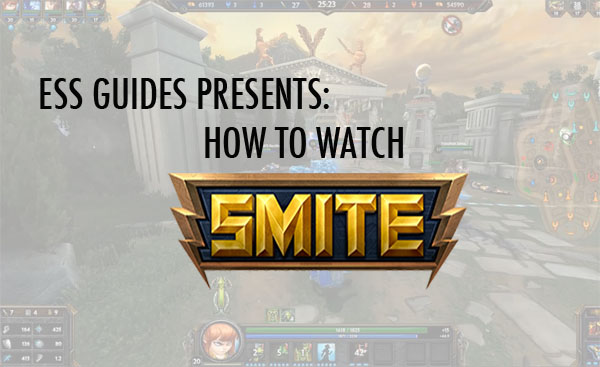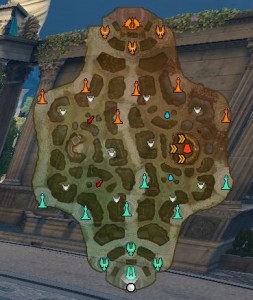
The following is a simple guide to watching and understanding SMITE. This guide is intended to initiate the very casual viewer, and allow them to be able to enjoy watching the weekly Pro League matches and the tournaments without struggling to figure out what is happening during the games.
TL;DR
SMITE is a MOBA (multiplayer online battle arena) game set in the realm of gods and goddesses from the world’s ancient and modern religions. The game is published by Hi-Rez Studios, which also runs its competitive divisions in North America and Europe. The game is available on PC, XBox One, and Playstation 4.
Players pick their god of choice, and face off against other human players who are also gods, and also computer controlled enemies known as minions. The game is one of strategy and fighting ability, with players having to choose from limited resources and also engage in combat with other human controlled gods.
Two teams of five players face off in on opposite sides of a map. The players all begin in their team’s fountain, where they start off with a certain amount of gold to buy items to help them in battle.
There are three lanes on the map, and each one is defended by a Phoenix at the opposite end. Players fight to control lanes by knocking down the opposing team’s two towers on each of the the lanes, defeating their minions, and gaining resources from defeating NPCs on either side of the lanes in the Jungle.
The first team to get to the enemy’s base and destroy the Titan waiting inside will win.

Let’s go a bit further.
The Game
The two teams of five players pick gods and goddesses from the various pantheons (Greek, Roman, Chinese, Egyptian, Norse, Hindu, Japanese, and Mayan). When you split up the pantheons, the gods themselves are sorted into five different classes: Assassin, Guardian, Hunter, Mage, or Warrior. The SMITE classes are then split into four different roles: ADC, Solo, Jungle, Mid, and Support. If you’ve taken a peek at our ESS Guide to League of Legends, these roles will sound very familiar, but we’ll provide a refresher below just in case.
Note: no two players from one team can pick the same god in competitive mode.
The gameplay goes something like this: the players begin at opposite sides of the map in their team’s found. While in the fountain, the players have time to buy items with the gold granted to them upon starting. The items they buy will grant special powers or bonuses to customize and enhance the god. Players can return to the fountain at any time during the match to buy more items and heal themselves.
When the match clock begins, small soldiers with low attack power and low health called
“minions” will spawn from the players’ fountains. These minions spawn every 30 seconds, and they run the length of the three lanes of the map. The first enemies the minions will fight (other than the human-controlled gods) are the enemy towers in each lane. The defensive towers deal damage to enemy players and minions if they get too close. Minions will attack other minions, enemy players, Phoenixes, and the enemy Titan.
Minions get significantly more attack power when an enemy Phoenix is destroyed. Phoenixes are strong defensive monsters located at the end of each of the three lanes. When an ally tower is destroyed, the Phoenix’s maximum health drops, so it’s often in a team’s interest to get as many enemy towers down as they can before going after a Phoenix.
An important part of the game strategy involves the Jungle. As noted above, the areas between the three lanes on the map are called the jungle, and that’s where NPC monsters spawn at specific locations. Killing these monsters provides certain buffs (spells that increase a certain player attribute like mana or damage for a limited time) that drop to the ground where they can be picked up by any member of the team. Other monsters offer experience and gold for players who kill them. One player usually roams the jungle area to farm for buffs, experience, and gold for their team.
As the players work their way toward the other side of the map, they gain experience points from killing other players and NPCs. This allows the player to level up as they play. The maximum level is 20. As a player levels, they gain increased abilities, and they can put experience points toward these abilities to make them stronger in certain attack modes earlier in the game.
The two big monsters are the Fire Giant and the Gold Fury. When the Gold Fury is killed, it grants the entire team a set amount of gold, which can be used to buy powerful weapons, armor, or consumable items in the team’s fountain. When the Fire Giant is killed (often late in the game), the entire team receives a powerful damage buff.
If a team finds themselves locked in a long and un-winnable battle, they can surrender the match, and give the win to the enemy team.
Once the Phoenixes are killed, they can respawn, so it is key for a team to get the Phoenixes down and then take on the enemy Titan before they respawn.
Player Classes
Assassin: Melee players who deal a lot of physical damage. Their goal is to get in, kill, and get out as quickly as possible. These gods typically attack with surprise attacks, or by finding enemies who are out of position and pouncing on them. Assassins typically are lightly armored with very low health pools, thus the reason they have to kill their enemies very quickly. Typically assassins will try to take out a single target at a time.
Guardian: The opposite of the nimble and squishy assassin are the big and powerful Guardians. They are typically gods who deal magical damage. Guardians have the highest health pools, and they have some form of crowd control attacks at their disposal, so they can take on multiple enemies and defend well. The Guardian typically initiates team fights and take damage for the other players.
Hunter: These are often the players the Guardians work hard to keep alive, as they are players with low health pools and light armor who deal large amounts of ranged burst damage. Hunters always have some kind of escape, since they are absolutely not meant to fight in close quarters. Hunters often rely on better items to increase their damage output, so they really begin to shine in the mid-to-late game.
Mage: These gods deal magical damage, and can often be found in the solo lane due to their ability to heal themselves. Mages have a diverse range of abilities over the collection of gods, and there are many play styles and positions that work well for this class.
Warrior: Another diverse group are the Warriors. They deal out physical melee damage, but their health pools are higher than Assassins. They can stay in fights for a long time, and the play styles and abilities are as diverse as the pantheons. Some are ability focused, others are about building the god with items to increase damage and protection, while others have high health pools but mainly focus on single targets, meaning they are a big distraction for the enemy.
Roles
Information about in-game roles typically changes with each season, as the developers tweak the Conquest map, and players determine a new meta for the game. Below is a very basic rundown of the roles, since you will likely hear commentator refer to them during matches.
ADC: “Attack Damage Carry”, a term borrowed from League of Legends. The player in this role attacks towers, and deals a lot of late game damage. Hunters and ranged mages usually fill this role. ADCS go to the long/duo lane (the lane with the towers furthest apart). They are joined by a Support player because ADCs tend to have low health pools.
Support: As mentioned above, Support begins in the long lane with an ADC. The Support also helps out the other lanes when needed once the ADC is able to be left on their own. Guardians typically take on this role, as they have relatively low damage output, but high defensive abilities that can absorb a lot of enemy damage.
Jungle: The jungler clears the NPC monster camps in the jungle, collecting plenty of gold and experience for the team. The jungler can also put pressure on the other lanes by attacking enemies by surprise, or simply coming by to help teammates who are struggling in a fight. Assassins usually take on the Jungle role, using their ability to jump in and out of a fight.
Mid: The midlaner goes to the middle lane of the map, which also has the shortest distance between its towers. Mid players are often high damage dealers who can clear groups of enemies. The mid player is often responsible for the jungle spawns in that area as well. Mages often fill this role.
Solo: The solo lane role is a diverse one, and usually a diverse class, like warriors can be found in the lane. Solo players are high damage gods that must be able to hold their own in one on one battles while also helping Support players on the map.
Watch a Game
As always, the best way to learn about a game is to watch a commentated match!
Here’s a look at a match from the 2016 SMITE World Championship:
Bonus
The Hi-Rez co-founder and COO told us all about the game at the 2016 World Championship. Have a look:

